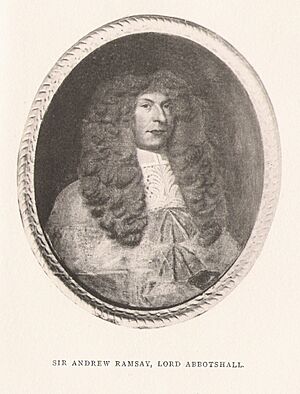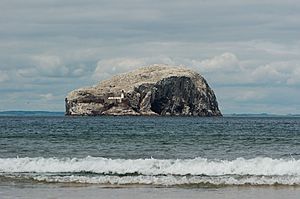Andrew Ramsay, Lord Abbotshall facts for kids
Sir Andrew Ramsay, Lord Abbotshall (born May 1619 – died 17 January 1688) was a very important person in Edinburgh's history. He was the first person to be called the Lord Provost of Edinburgh, which is like being the mayor of the city. He was also a judge in the Court of Session, which is Scotland's highest court.
You can still see his name in Edinburgh today! Ramsay Gardens and Ramsay Lane are named after him. His old house was located near where Ramsay Lane is now, close to the Camera Obscura.
Contents
Family Life
Andrew Ramsay was the third son of Reverend Andrew Ramsay. His father was a minister at the Old Kirk in Edinburgh and also taught at Edinburgh University. His mother was Mary Frazer.
Becoming Lord Provost
Sir Andrew Ramsay was a very successful merchant, which means he was good at business. In 1652, he became the youngest Bailie of Edinburgh. A Bailie was like a city council member who helped manage the city.
In 1654, he became the Provost of Edinburgh, a role he held until 1658. This was a challenging time because the city council had to get many of their decisions approved by Oliver Cromwell in London.
From 1665, he also served as the Rector and Governor of Edinburgh University. During his time there, he made a big change by stopping the use of corporal punishment, which was physical punishment for students.
In 1662, he was elected Provost again, and he stayed in this position for eleven years. The city council was almost out of money when he took over. Sir Andrew made many strong decisions to fix the city's finances. For example, in 1665, the council fired the Town Clerk, Sir William Thomson, because of problems with how he handled money. Sir Andrew's second son, William Ramsay, then became the new Town Clerk.
A big change happened in 1667. King Charles II sent a letter saying that from then on, the main leader of Edinburgh should always be called the Lord Provost of Edinburgh. This title gave the Edinburgh leader the same high rank as the Lord Mayor of London and Dublin.
Politics and Public Service
Sir Andrew Ramsay also represented Edinburgh in the Parliament of Scotland from 1665 to 1674. During this time, he became friends with John Maitland, 1st Duke of Lauderdale.
He joined the Privy Council of Scotland, which was a group of advisors to the King. He also became a judge in the Court of Exchequer. On 23 November 1671, the King appointed him as a judge in the Court of Session, giving him the title Lord Abbotshall. Even though he wasn't a trained lawyer, he was still given this important role.
However, not everyone liked him, and some people in Edinburgh and even the Duchess of Lauderdale worked against him. Because of this, he lost his offices on 1 December 1673. But he was later allowed to rejoin the Privy Council on 5 August 1675.
He lived long enough to see many of his opponents, who had worked against him, also lose their important positions.
The Bass Rock Deal
Sir Andrew Ramsay owned many properties during his life. Besides Abbotshall in Fife, which became his family's main home and gave him his title, he bought other large estates.
In 1671, Lord Abbotshall bought the Bass Rock for £400. The Bass Rock is a large island in the sea. He then convinced the Duke of Lauderdale to have the government buy it from him for a much larger sum of £4000. Some people, like Sir George Mackenzie, thought this was a very clever business deal, saying that Ramsay and Lauderdale "were kind to one another upon His Majesty's expenses."
Marriage and Later Life
Sir Andrew Ramsay passed away at Abbotshall when he was 69 years old. He was married to Janet Craw.
They had several children:
- Sir Andrew Ramsay, 1st Baronet, who was his main heir.
- Janet, who married Sir John Lauder, Lord Fountainhall.
- Helen, who married Alexander Hay.
- Margaret, who married George Home.
Images for kids





